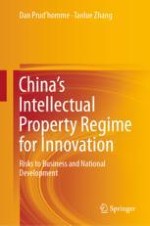2019 | OriginalPaper | Chapter
3. Chinese Patenting Trends and the Role of the State
Authors : Dan Prud’homme, Taolue Zhang
Published in: China’s Intellectual Property Regime for Innovation
Publisher: Springer International Publishing
Activate our intelligent search to find suitable subject content or patents.
Select sections of text to find matching patents with Artificial Intelligence. powered by
Select sections of text to find additional relevant content using AI-assisted search. powered by
